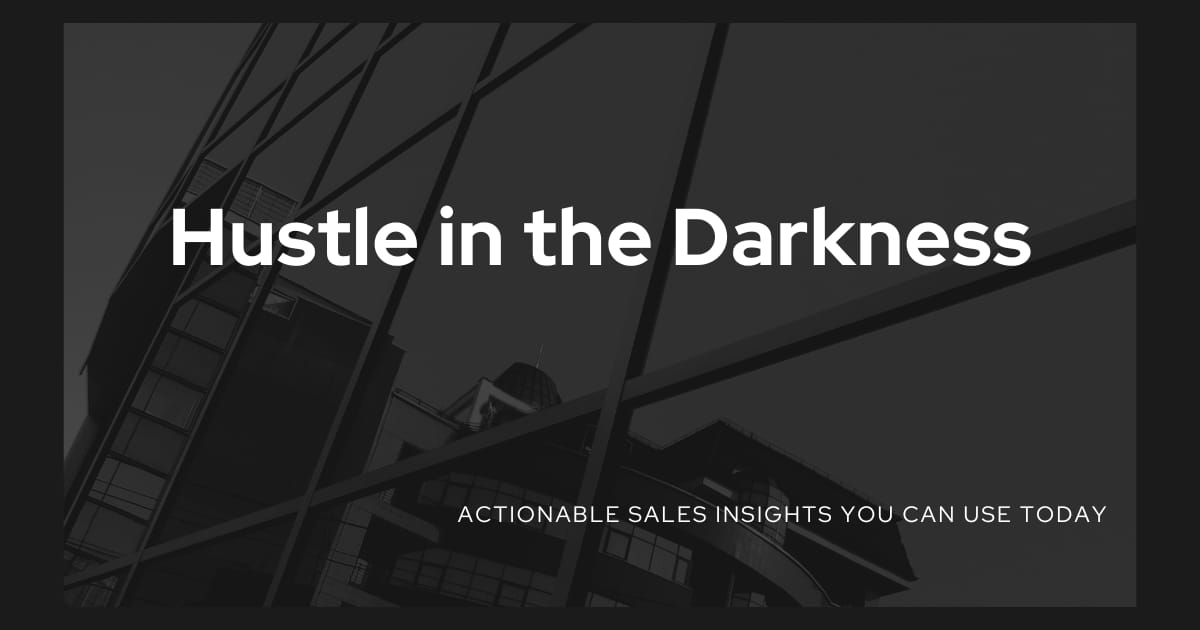Read on: My website
Read time: 2 Minutes
This week’s newsletter came at the request of an avid reader. Thank you! We had a great, in-depth conversation over this topic and how it impacts their day-to-day, their team, and how they pursue new projects. Thank you for reading and supporting Hustle in the Darkness!
Imagine you’re staring at a project that’s draining your team, you're burning through cash, resources, consultants, and it’s keeping you up at night. You’ve poured everything into this.
The world says “push through.” Your gut whispers, “Is this still worth it?”
What…do you do?
No one doubts your hustle. But what you see in front of you might not be a bridge too far for you to overcome.
How can you know when to quit, when to pause, and when to double down?
That is what we are going to explore here.
Was this newsletter forwarded to you?
We don’t want to let ego get in the way of when you should make the right moves to pull you (and your team) from projects that you cannot recover from.
What should you look forward to, and what is a framework you can apply? That’s what we are going to dive into in this issue.
Let’s dance.
When the Hustle Isn't Working: Your 5-Step Framework for Leaders Who Refuse to Quit the Wrong Things
Every executive I know has been here: You're deep into something that once felt promising, but now you're questioning everything. The metrics aren't moving. Your team is frustrated. You're burning through resources. And you're standing at the crossroads trying to figure out what to do next.
I’ve talked about this in the past:
You have three options: knowing when to quit, when to pause, and when to push through.
This isn't about giving up. This is about playing an infinite game with finite resources. It's about leading with purpose while making decisions that create sustainable impact.
Most leaders get trapped in this messy middle. They confuse persistence with progress because they play finite games in infinite contexts.
The Practical Test for Leaders:
When facing a critical decision, ask yourself: "Is this feeling telling me to move toward opportunity or away from threat?"
Pressure: Usually drives avoidance behavior ("We have to get out of this situation")
Instinct: Usually drives approach behavior ("This feels like the right direction for our mission")
Why Should I Care About This?
According to Harvard Business Review, 70% of organizational change initiatives fail, not because of poor strategy, but because leaders don't know when to pivot, persist, or pause. The cost of getting this wrong is staggering: misallocated resources, team burnout, and missed opportunities that compound over time.
But here's what most executives miss: This isn't about right versus wrong decisions, it's about strategic thinking versus stubborn attachment. Research from MIT shows that leaders who develop systematic decision-making frameworks for these situations create organizations that are 67% more likely to outperform competitors over 10-year periods.
The reality is simple: In an infinite game like business, the goal isn't to win every battle, it's to stay in the game long enough to advance your just cause. Companies led by executives who understand this distinction, like Amazon's willingness to shut down failed initiatives while doubling down on their long-term mission, create sustainable competitive advantages that last decades.
Every quarter you stay too long in the wrong pursuit, you're saying no to the right one. Every month you quit too early, you're abandoning potential breakthroughs. The leaders who build lasting organizations master this balance
When the Hustle Isn't Working: Your 5-Step Framework
Here's your 5-step framework for making decisions that align with both your immediate reality and your infinite purpose:
Step 1: Separate Your Metrics from Your Mission
Before you make any decision about quitting, pausing, or pushing through, get clear on the difference between what you're measuring and why you're measuring it. Your mission is infinite—it's the just cause that transcends any single initiative. Your metrics are finite—they're snapshots of progress toward that cause.
Key Questions:
Does this initiative still serve our larger mission, even if the current metrics don't look good?
What would happen if you did a Go/No Go today? Would you still pursue the project?
Are we measuring the right things, or are we measuring what's easy to measure?
What would success look like if we were optimizing for impact over efficiency?
Real-world application: When Reed Hastings decided to kill Netflix's DVD business while it was still profitable, he wasn't abandoning the mission; he was recommitting to it. The mission was to give people access to entertainment on their terms. DVDs were just one way to serve that mission.
Step 2: Build Your Decision Around Trust, Not Fear
Fear-based decisions optimize for avoiding loss. Trust-based decisions optimize for creating value. When you're deciding whether to continue, pause, or quit, ask yourself: What would this decision look like if it came from a place of confidence in our team and commitment to our cause?
Key Questions:
Are we making this decision because we're afraid of admitting we were wrong?
What would we do if we trusted our team's ability to adapt and learn?
How does this decision affect the safety and trust within our organization?
Real-world application: When Airbnb faced massive losses during COVID-19, they didn't just cut costs; they recommitted to their core mission of belonging. They paused expansion but doubled down on host support and safety, emerging stronger because the decision built trust rather than destroying it.
Step 3: Test for Learning versus Repeating
The difference between productive persistence and stubborn attachment is learning velocity. If you're learning quickly and adapting based on that learning, you're probably in the right place. If you're just repeating the same approaches, hoping for different results, it's time to pause or pivot.
Key Questions:
What have we learned in the last 6 months that changed how we operate?
Are we getting better at solving the core problem, or just getting better at managing the symptoms?
When was the last time we fundamentally questioned our approach based on new evidence?
Real-world application: Amazon's approach to failed initiatives is legendary; they fail fast, learn faster, and apply those learnings to new ventures. The Fire Phone was a massive failure, but the learnings led directly to Alexa's success.
Step 4: Evaluate Your Worthy Rivals, Not Your Competition
Worthy rivals aren't competitors to beat; they're players who challenge you to get better. When deciding whether to continue a pursuit, look at who else is playing in this space and ask: Are they making us stronger, or are we just trying to beat them?
Key Questions:
What are our worthy rivals doing that we can learn from?
Are we innovating because of competitive pressure, or just reacting to it?
How would our approach change if we stopped trying to beat others and started trying to better ourselves?
Real-world application: Apple doesn't try to beat Google; they learn from Google's strengths while staying true to their own values around privacy and design. This approach has made both companies stronger.
Step 5: Set Decision Criteria That Honor Both Finite Results and Infinite Purpose
Create specific conditions that will trigger your next decision point, but make sure those conditions account for both immediate performance and long-term mission alignment. This prevents indefinite drifting while ensuring you don't abandon something valuable for short-term pressures.
Key Actions:
Define success metrics that include both financial performance and mission advancement
Set review dates that allow enough time for real progress but prevent endless drift
Create accountability structures that include both external advisors and internal stakeholders
Establish clear criteria for what would cause you to accelerate, pause, or exit
How Improving Your Position in This Can Help You Win
Mastering this framework transforms you from a reactive manager into an infinite leader who builds antifragile organizations.
When you get comfortable with strategic decision-making in the messy middle, several powerful things happen:
You Build Institutional Wisdom: Each decision becomes data that improves your organization's collective judgment. Your team learns to distinguish between temporary setbacks and permanent dead ends.
This wisdom compounds over time, making future decisions faster and more accurate.
You Attract and Retain Top Talent: Great people want to work for leaders who make thoughtful decisions under pressure. When your team sees you make a difficult but well-reasoned choice to pivot or persist, they gain confidence in your overall leadership.
According to Gallup, employees are 67% more engaged when they trust their leader's decision-making process.
You Create Sustainable Competitive Advantage: Every resource you reallocate from the wrong pursuit to the right one increases your capacity to serve your mission.
Organizations that master this balance don't just survive market changes, they shape them.
You Develop Infinite Leadership Capability: Each time you use this framework, you get better at thinking beyond quarterly results toward generational impact.
You start making decisions that honor both your immediate constraints and your ultimate purpose.
What the Internet Taught Me This Week
From new tools, recent trends, and market updates, here is what has been on my mind.
Meteorologists Say the National Weather Service Did Its Job in Texas. Lots more to come on the DOGE fallout. Check it out here
Great YouTube Channel, SmarterEveryDay, breaks down the challenge of making a Grill Scrubber in the USA. Check it out here
Tech companies have eliminated more than 94,000 jobs this year and replaced them with AI systems. Check it out here
The best leaders aren’t the ones who never quit, they’re the ones who know exactly when to.
Don’t let pride or pressure keep you stuck in the wrong fight. Take your ego out of it, no matter how much time, energy, or effort you have sunk into it.
Make your call, own it, and move forward with clarity.
Because in business, the real win isn’t proving you can outlast everyone, it’s knowing you’re playing the right game.
See you next week.
Whenever you're ready, here are 4 ways I can help you:
Unlocking Hidden Potential - Reconnecting with Past Clients for Explosive Growth - Check out my free eBook on how you can find hidden gems in your past clients and help you crush your sales goals.
Build your Sales CRM - Download our free Sales eBook on How Your Sales Team Can Maximize Your CRM Tool. Whether it’s Hubspot, Salesforce, or another CRM tool, make sure you leverage it to your advantage.
Awesome Sales Resources - Transform your sales engagement and capabilities across Social Selling, CRM, Lead Generation, Enablement, and more.
Cribworks Advisor Program - Want more than just resources? Reach out to me and see if our Advisor Program can help you grow your business.

